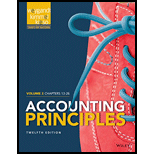
Concept explainers
Inventory: It refers to the total stock of such goods or items which are held by the business organizations with the purpose of sale.
Inventory turnover: It refers to that number of times or rate at which inventory of the firm is purchased and sold during a particular time period.
Days in inventory: It refers to that number of days for which the inventory remains with the company before it is sold.
Gross Profit Rate: It is the financial ratio that evaluates the money left out of the total revenues after deducting the cost of goods sold. Thus, it shows the relationship between the gross profit on sales and net sales.
To determine: The inventory turnover, days in inventory, and gross profit rate of A Corporation for each year.
Want to see the full answer?
Check out a sample textbook solution
Chapter 6 Solutions
Accounting Principles, Volume 2: Chapters 13 - 26
- What is the answer of this a.b. ? General accounting questionarrow_forwardDo fast answer of this accounting questionsarrow_forwardChapter: Accrual Accounting - Jim Corporation's liability account balances at June 30, 2023included a 10 percent note payable. The note is dated October 1, 2021, and carried an original principal amount of $600,000. The note is payable in three equal annual payments of $200,000 plus interest. The first interest and principal payment was made on October 1, 2022. In Jim's June 30, 2023 balance sheet, what amount should be reported as Interest Payable for this note? Answerarrow_forward

 AccountingAccountingISBN:9781337272094Author:WARREN, Carl S., Reeve, James M., Duchac, Jonathan E.Publisher:Cengage Learning,
AccountingAccountingISBN:9781337272094Author:WARREN, Carl S., Reeve, James M., Duchac, Jonathan E.Publisher:Cengage Learning, Accounting Information SystemsAccountingISBN:9781337619202Author:Hall, James A.Publisher:Cengage Learning,
Accounting Information SystemsAccountingISBN:9781337619202Author:Hall, James A.Publisher:Cengage Learning, Horngren's Cost Accounting: A Managerial Emphasis...AccountingISBN:9780134475585Author:Srikant M. Datar, Madhav V. RajanPublisher:PEARSON
Horngren's Cost Accounting: A Managerial Emphasis...AccountingISBN:9780134475585Author:Srikant M. Datar, Madhav V. RajanPublisher:PEARSON Intermediate AccountingAccountingISBN:9781259722660Author:J. David Spiceland, Mark W. Nelson, Wayne M ThomasPublisher:McGraw-Hill Education
Intermediate AccountingAccountingISBN:9781259722660Author:J. David Spiceland, Mark W. Nelson, Wayne M ThomasPublisher:McGraw-Hill Education Financial and Managerial AccountingAccountingISBN:9781259726705Author:John J Wild, Ken W. Shaw, Barbara Chiappetta Fundamental Accounting PrinciplesPublisher:McGraw-Hill Education
Financial and Managerial AccountingAccountingISBN:9781259726705Author:John J Wild, Ken W. Shaw, Barbara Chiappetta Fundamental Accounting PrinciplesPublisher:McGraw-Hill Education





